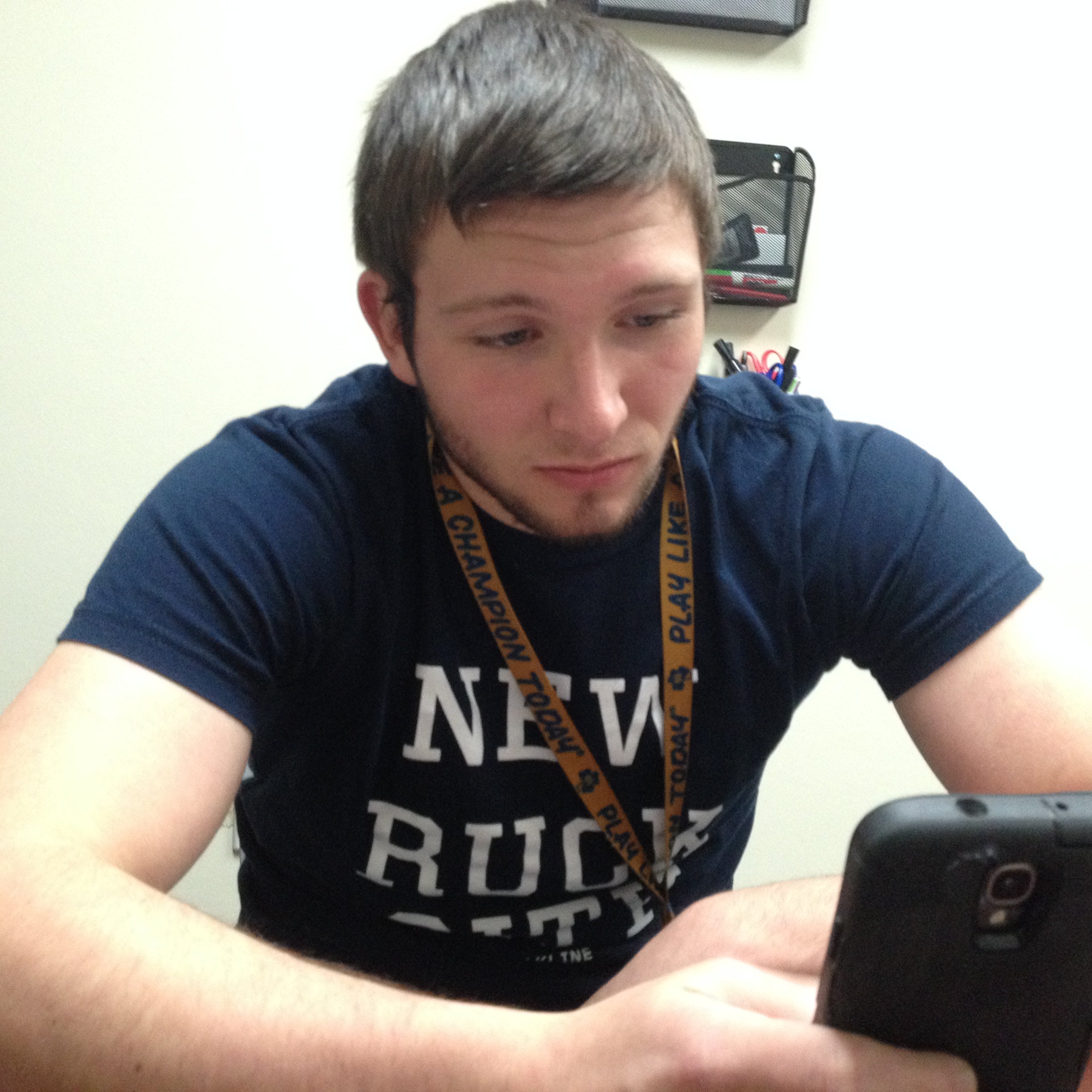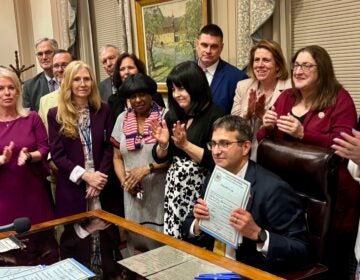Can a text message get Delaware students to college?
Listen
(Avi Wolfman-Arent/WHYY)
Applying for college is tough enough, but some colleges are trying something different as a way to help.
Delaware’s latest college readiness initiative begins at the nexus of two pretty convincing assumptions:
1.) Teenagers like to text. 2.) Applying to college is difficult.
The first assumption borders on hard fact. A 2012 Pew survey found that the average teenager sends 60 texts a day, and that texting is far and away the most common way teens communicate.
The second assumption likely rings true for anyone who has either applied to college in the last decade or tried to coax a teenager through the process.
It’s also the subject of considerable academic study.
University of Pittsburgh researcher Lindsay Page’s work focuses in particular on “summer melt,” the theory that many students, particularly low-income students, fail to enroll in college specifically because of the financial and logistical challenges they encounter between graduating high school in spring and matriculating the next fall. Along with her colleague, University of Virginia professor Benjamin Castleman, Page has tested a number of interventions aimed at easing this transition.
“We started out very low-tech, having counselors or college advisors basically receive a caseload of students,” Page said. “And it was the responsibility of the counselor or advisor to use all of the modes of communication at their disposal to reach out to the students. So it would be calling and emailing.”
The initial results were uninspiring. So Page and Castleman turned to the device teenagers use most — their phones — and the thing they’re most likely to do on that device — text.
“It’s a deceptively simple idea,” Page said.
In the summer of 2012, Page and Castleman set up an experiment. They started with groups of recent high school graduates in Texas and Massachusetts. Some received periodic reminders, ten in all, reminding them to complete paperwork, fill out housing forms, and take placement tests. Others received nothing.
In certain populations, the text messages led to a seven percent bump in college enrollment. In others, the effect was minimal. Overall, though, the results, which will be published later this year in the Journal of Economic Behavior & Organization, convinced Page and Castleman that their deceptively simple solution could have real world application.
“This is definitely something that is very promising,” Page said.
Delaware is the first to take the texting program statewide — and beyond the contours of a carefully-designed experiment. Each of Delaware’s 8,726 high school seniors were eligible to receive the messages, which began in January rather than over the summer. More than 4,000 students have enrolled and 363 of their parents.
A computer program sends out a batch of approximately 400 texts over the course of two hours about three times a month. They are tailored based on where the students are in the application process. Students who have completed the Free Application for Federal Student Aid (FAFSA) may receive different notices, for example, than those who haven’t. As students pick their schools, some will receive notices specific to their future plans.
As cell phones across the state buzz and ping, a team of about ten from University of Delaware’s Institute for Public Administration fields responses.
“A lot of pop culture references come up,” said Shana Payne, director of the Delaware Department of Education’s Higher Education Office, with a laugh.
Yes, there are thousands of teens on the receiving end of these messages — which means responses may be curse words, texts intended for other recipients, and weird adolescent brags.
“The guy was asking if I wanted to see him do burnouts on his four-wheeler,” said Laura Wisniewski, a student at the University of Delaware’s Institute for Public Administration.
Most responses, though, seem born of simple confusion. Stumped seniors ask about scholarship applications or half-completed FAFSA forms. If left unanswered, these questions could become missed deadlines or dead ends in the quest for an affordable college education.
“Even after students apply to college there are many time-sensitive tasks they need to keep up with,” Page said. “Really the goal is to say hey, don’t forget you need to do this thing. Do you have questions about doing this?”
The Federal Communications Commission prohibiting texting people without their explicit permission. That means Delaware students must opt into program. But it also means the department’s texts don’t compete with dozens of spam emails, robo phone calls, or Facebook ads.
This direct communication tactic can be a boon.
In 2008, the Obama campaign famously announced it’s Vice Presidential nominee via text, and used text messaging to great acclaim as a fundraising and voter-turnout tool. Text messages have been used to promote HIV/AIDS awareness in the developing world, help smokers quit, and encourage weight loss.
The intervention, in other words, is not new. The application, however, is.
When Page and Castleman tested their college texting program, it produced mixed results. Students in Lawrence and Springfield, Massachusetts, for instance, were about seven percent more likely to enroll in college after receiving the texts. Dallas produced a more modest enrollment bump of 2.4 percent. Students in Boston were a tad less likely to enroll after the text-message deluge.
The researchers attributed this range of results to the fact that Boston students already had access to an abundance of college readiness programs. Students elsewhere were more isolated, and thus more likely to benefit from a digital nudge.
It’ll be a while before Delaware officials can surmise the overall impact of their pilot campaign. So far, 42 percent of students have responded to at least one text message, according to the Department of Education’s Higher Education Office. That number response rate is higher than those in Dallas (31 percent), Springfield (34 percent), and Boston (37 percent), but lower than Lawrence (48 percent).
The Bill and Melinda Gates Foundation is covering the $80,000 tab for this year’s campaign. Given the number of participants, the cost per person comes out to about $18. Page says that number is a bit high because the state had to sign a contract before it knew how many parents and students would enroll. In an experimental setting, she and Castleman were able to deliver the same product for $7 a head.
It’s tricky, at this juncture, to do a cost-benefit analysis of the entire program. Page doesn’t know, for example, if those extra seven percent will complete college or drop out when their next FAFSA form comes due. And if students do drop out, the texts will have been little more than a vehicle for debt.
On the sunnier side, it’s possible the texts can help students who were already college-bound secure extra scholarship money and more favorable loans. The research has not yet attempted to measure this impact, but there’s anecdotal evidence to support it.
Take the case of Pierce Armstrong, a senior at Hodgson Vo-Tech School in Newark, Delaware.
Armstrong was likely college bound before he ever received a text from Shana Payne and the Higher Education Office. But he knew little about financial aid, and realized his parents — one of whom didn’t attend college and one of whom went to a local university — couldn’t offer much help.
“They were able to give me the push and a little bit of insight into things, but overall they didn’t understand the process,” Armstrong said.
After botching a couple of scholarship applications, Armstrong realized he was adrift.
“It’s the senior year and I was kind of on that fence, like, what do I do? How do I do it,” Armstrong said. “I needed help.”
After a few text exchanges he’s now filled out a couple of scholarships, completed his FAFSA, and applied to three colleges. As of now, he’s planning to attend Kutztown University in Pennsylvania this fall.
Armstrong already spends, by his estimate, about two-to-two-and-a-half hours a day texting. A few minutes more chatting about college hardly seemed an intrusion.
WHYY is your source for fact-based, in-depth journalism and information. As a nonprofit organization, we rely on financial support from readers like you. Please give today.





